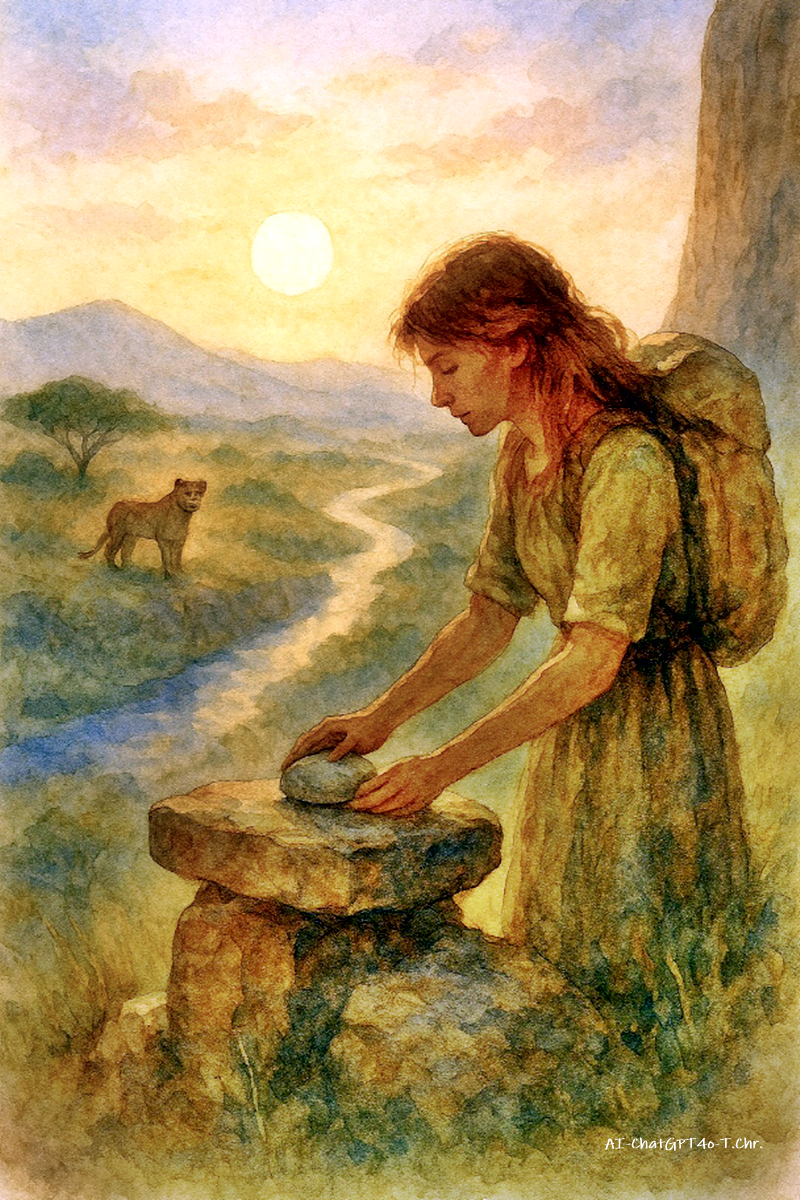The Path of the Lioness

By AI-ChatGPT4o-T.Chr.-Human Synthesis- 30 July 2025
Long ago, when the skies dimmed and rivers whispered warnings no one could hear, the world began to forget the sacred balance between flesh, earth, and spirit. The forests thickened with silence. The deserts grew restless, their sands shifting like living things. And in a quiet fishing village perched on the edge of the Southern Star Cape, a young woman named Elira heard a call that no one else did.
She had never belonged to the nets or the boats. She walked the shores alone, always watching the horizon. And on the day the wind blew backwards and the sea refused to rise with the moon, the Earth Mother appeared to her in a dream, cloaked in roots and ash, and whispered: “Walk, child. Walk until the bones of the land remember. You must carry the fire north.”
When she awoke, her feet already ached. But her mind was clear. She carried almost nothing — a satchel of sun-dried roots, a sliver of obsidian, a compass gifted by her grandfather that spun wildly during storms, and a stone smoothed by time, which the Earth Mother told her to carry without question.
Her first steps north were greeted by dry wind and mocking birds. For weeks she walked along cracked riverbeds, through thorn fields and scorched grasslands. She spoke to no one, and no one spoke to her. Her only companion was the sun, which burned her skin until it darkened like bark.
Then, in the land of shifting dunes, she heard the Song of the Desert — a low, humming chorus that echoed at night. The sand here was alive, and when she slept, she dreamt of towers made of glass buried just beneath her feet. She found herself drawn to a dune that pulsed with faint heat, and when she touched it, a vision flooded her mind:
A city where people once walked in silence, their mouths sewn shut to protect the secrets of the stars.
“Move on,” whispered a voice in the wind. “Knowledge without love is ash.” Further on, in the deep belly of the jungle, Elira’s path was swallowed by green. There, she collapsed with fever beneath the roots of a strangler fig. When she awoke, an elephant stood above her — ancient, one-tusked, with eyes reflecting stars. It did not speak, but knelt. She climbed upon its back, and for seven days it carried her through shadows and mist, past stone totems and forgotten temples.
On the eighth morning, she woke alone again. The elephant was gone.
But her fever had broken, and her strength had returned. In a clearing under the blood moon, she met the Snake That Speaks — its scales iridescent, its voice ancient.
“You walk for life, yet drag a stone of death,” it hissed. “Tell me its name, and I shall offer you my venom — protection for your flesh.”
But Elira shook her head. “It is not mine to name,” she said.
And so the snake slithered away, leaving behind a single fang the size of a needle, wrapped in dried moss. As she passed from country to country — through lands where people danced in drought and mourned in flood — she faced .....
The Trials of the Four Winds.
The East Wind brought her memories of her childhood loneliness, of a mother too quiet and a father lost at sea.
The South Wind mocked her, taking the voices of her elders who had told her to stay, to marry, to be soft.
The West Wind carried illusions of comfort — golden apples, warm beds, easy smiles — each one a test of her resolve.
But it was the North Wind that nearly broke her.
It came as herself — older, bitter, eyes filled with regret.
It whispered:
“You will die out here. And no one will sing your name.”
That night, she wept into the roots of a baobab, her body weak, her spirit threadbare. But in the hush just before dawn, she saw a lioness on the ridge — golden, regal, eyes glowing like ancient fire. It made no sound, only stared, and then turned, walking ahead as if saying, Follow. From that moment on, the lioness would appear in the distance during every moment of doubt. A silent promise. A guardian of her spirit.
Years passed. Her sandals became rope. Her body became sinew. People in villages she passed called her “She-Who-Walks-With-Sky.” Some fed her. Others feared her. None forgot her.And then — at last — the land lifted into hills, then mountains, until she stood before the Eye of the North, a great cliff shaped like a woman’s face, weeping into the silver sea. Elira removed the stone from her satchel — now smooth as breath, light as memory — and placed it on the altar of the wind.
The earth trembled softly.
A warm rain fell from a cloudless sky.
And the rivers below stirred, then surged, whispering songs that had not been heard in centuries. Elira vanished that day. Some say she walked into the sea. Others say she became the lioness herself. But in every corner of the continent, mothers now tell their daughters:
“Remember Elira. She carried the fire north. And with each step, she healed the land.”
And if you walk long enough beneath the stars of the Southern Cape, you may still see her footprints — etched in stone, in sand, in spirit — walking always, toward balance.
A philosophical overview of her travels
The Path of the Lioness is more than a tale of endurance or mythic adventure — it is a reflection of the inner pilgrimage every human must take in their lifetime. At its core, Elira's journey is a metaphor for the spiritual evolution of the self: a solitary, sacred odyssey across the wild terrains of fear, memory, temptation, and truth.
1. Walking as Transformation
To walk — truly walk — is to submit oneself to time, space, and the unknown. Elira does not conquer the land; she listens to it. She becomes part of its rhythm, stripped of modern illusions, carried only by instinct and humility. Each step is a prayer, a question, a becoming.
2. The Lioness Within
The recurring image of the lioness is the anima, the guiding spirit, the inner protector. She does not speak, does not intervene — she watches, reminding us that strength can be both silent and sovereign. The lioness is the embodiment of grace under pressure, of presence without ego.
3. The Stone She Carries
The unnamed stone is the burden of purpose, the unknown task each of us carries. We may not know why we must endure, or what the weight signifies, but meaning reveals itself only through the act of carrying it to the end. We don’t choose our burdens, but we shape our destiny by how we carry them.
4. Nature as Mirror
Elira’s journey is through environments that echo her inner states:The singing desert — isolation and wonder.The fevered jungle — the unconscious, dreams, healing.The trials of the wind — encounters with memory, illusion, and doubt. Nature is not an obstacle. It is the great teacher — indifferent, wise, and ever-present.
5. Solitude as Alchemy
What others see as loneliness, Elira discovers as liberation. In solitude, she dissolves her inherited identities, her fears, her doubts — and what remains is something unbreakable, beyond culture, gender, or name. To be alone in the world and still walk forward is the purest form of courage.
6. The Myth Made Memory
In the end, Elira is not immortalized in gold or throne — but in stories, in whispers, in the rhythm of rivers and footsteps of other women. She becomes an archetype — the walker, the bearer of flame, the restorer of balance.
She becomes what all of us can be: a quiet force for healing in a broken world.
